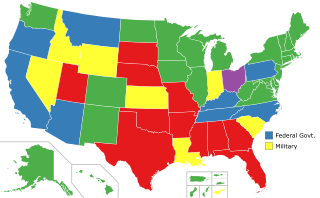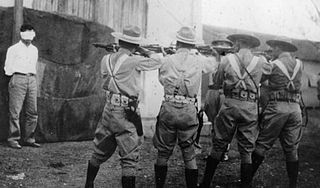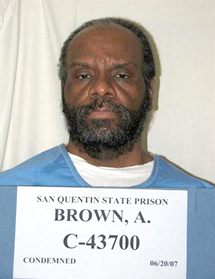Related Research Articles

Lethal injection is the practice of injecting one or more drugs into a person for the express purpose of causing rapid death. The main application for this procedure is capital punishment, but the term may also be applied in a broader sense to include euthanasia and other forms of suicide. The drugs cause the person to become unconscious, stops their breathing, and causes a heart arrhythmia, in that order.

In the United States, capital punishment is a legal penalty throughout the country at the federal level, in 27 states, and in American Samoa. It is also a legal penalty for some military offenses. Capital punishment has been abolished in 23 states and in the federal capital, Washington, D.C. Capital punishment is, in practice, only applied for aggravated murder. Although it is a legal penalty in 27 states, only 20 states have the ability to execute death sentences, with the other seven, as well as the federal government, being subject to different types of moratoriums. The existence of capital punishment in the United States can be traced to early colonial Virginia. Along with Japan, South Korea, Taiwan, and Singapore, the United States is one of five advanced democracies and the only Western nation that applies the death penalty regularly. It is one of 54 countries worldwide applying it, and was the first to develop lethal injection as a method of execution, which has since been adopted by five other countries. The Philippines has since abolished executions, and Guatemala has done so for civil offenses, leaving the United States as one of four countries to still use this method. It is common practice for the condemned to be administered sedatives prior to execution, regardless of the method used.

Capital punishment is a legal penalty in the U.S. state of Louisiana.
Capital punishment is a legal penalty in the U.S. state of Utah.
Capital punishment in the state of Washington was abolished on October 11, 2018 when the state Supreme Court ruled it was unconstitutional as applied. On September 10, 2010, Cal Coburn Brown became the last person to be executed in Washington State before it was abolished in 2018.
Capital punishment is a legal penalty in the U.S. state of Nebraska. In 2015, the state legislature voted to repeal the death penalty, overriding governor Pete Ricketts' veto. However, a petition drive secured enough signatures to suspend the repeal until a public vote. In the November 2016 general election, voters rejected the repeal measure, preserving capital punishment in the state. Nebraska currently has 12 inmates on death row.
Frances Elaine Newton was executed by lethal injection in the state of Texas for the April 7, 1987 murder of her husband, Adrian, 23, her son, Alton, 7, and daughter, Farrah, 21 months.

Hospira was an American global pharmaceutical and medical device company with headquarters in Lake Forest, Illinois. It had approximately 19,000 employees. Before its acquisition by Pfizer, Hospira was the world's largest producer of generic injectable pharmaceuticals, manufacturing generic acute-care and oncology injectables, as well as integrated infusion therapy and medication management systems. Hospira's products are used by hospitals and alternate site providers, such as clinics, home healthcare providers and long-term care facilities. It was formerly the hospital products division of Abbott Laboratories. On September 3, 2015, Hospira was acquired by Pfizer, who subsequently sold off the medical devices portion of Hospira to ICU Medical.
The execution van, also called a mobile execution unit, was developed by the government of the People's Republic of China (PRC) and was first used in 1997. The prisoner is strapped to a stretcher and executed inside the van. The van allows death sentences to be carried out without moving the prisoner to an execution ground.

Execution by shooting is a method of capital punishment in which a person is shot to death by one or more firearms. It is the most common method of execution worldwide, used in about 70 countries, with execution by firing squad being one particular form.
Capital punishment in Connecticut formerly existed as an available sanction for a criminal defendant upon conviction for the commission of a capital offense. Since the 1976 United States Supreme Court decision in Gregg v. Georgia until Connecticut repealed capital punishment in 2012, Connecticut had only executed one person, Michael Bruce Ross in 2005. Initially, the 2012 law allowed executions to proceed for those still on death row and convicted under the previous law, but on August 13, 2015, the Connecticut Supreme Court ruled that applying the death penalty only for past cases was unconstitutional.

Steven Howard Oken was an American spree killer who raped and murdered three women in Maryland and Maine in November 1987. He was sentenced to death and executed in Maryland by lethal injection in 2004.
Capital punishment is a legal penalty in the U.S. state of Idaho.
Capital punishment is a legal penalty in the U.S. state of South Dakota.
Participation of medical professionals in American executions is a controversial topic, due to its moral and legal implications. The practice is proscribed by the American Medical Association, as defined in its Code of Medical Ethics. The American Society of Anesthesiologists endorses this position, stating that lethal injections "can never conform to the science, art and practice of anesthesiology".
The Death Penalty Information Center (DPIC) is a non-profit organization based in Washington, D.C., that focuses on disseminating studies and reports related to the death penalty. Founded in 1990, DPIC is primarily focused on the application of capital punishment in the United States.

Capital punishment is a legal penalty in the U.S. state of Florida.

Albert Greenwood Brown Jr. is an American murderer and rapist who has been convicted of sexual molestation with force of a minor, two counts of first-degree rape with force, and the first degree murder of a teen girl in Riverside, California.
Hanging has been practiced legally in the United States of America from before the nation's birth, up to 1972 when the United States Supreme Court found capital punishment to be in violation of the Eighth Amendment to the United States Constitution. Four years later, the Supreme Court overturned its previous ruling, and in 1976, capital punishment was again legalized in the United States. As of 2021, three states have laws that specify hanging as an available secondary method of execution.
References
- 1 2 Pilkington, Ed (2015-04-29). "'It's problematic': inventor of US lethal injection reveals death penalty doubts". The Guardian. Retrieved 2021-09-13.
{{cite web}}: CS1 maint: url-status (link) - ↑ ""U.S., Index to Public Records, 1994-2018"", Ancestry.com
- ↑ Boyer Sagert, Kelly (2007). The 1970s . Westport, Conn.: Greenwood Press. pp. 37–38. ISBN 978-0-313-33919-6.
- ↑ Grady, Denise (2006-06-23). "Doctors See Way to Cut Suffering in Executions". The New York Times. Retrieved 2009-12-11.
- 1 2 Kutner, Max (2017-05-01). "Lethal injection inventor A. Jay Chapman: "I wish I had never been asked" to create it". Newsweek. Retrieved 2021-09-13.
{{cite web}}: CS1 maint: url-status (link) - ↑ Jacquette, Dale (2009). Dialogues on the Ethics of Capital Punishment (New Dialogues in Philosophy) . Rowman Littlefield Publishers, Inc. pp. 98–99. ISBN 978-0-7425-6143-4.